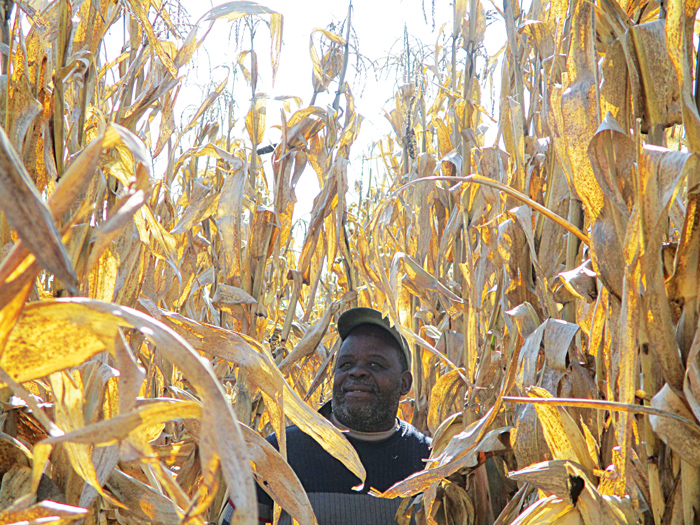October 2021
| JENNY MATHEWS, MANAGEMENT AND DEVELOPMENT SPECIALIST AND EDUCATOR |
 |
Between 26% and 40% of the world’s potential crop production is lost annually because of weeds, pests and diseases. Many farmers use chemicals to keep weeds and pests from destroying their crops – this is called crop protection.
Crop protection is the science and practice of managing plant diseases, weeds and other pests that damage agricultural crops. This covers all practical aspects of pest, disease and weed control.
PESTICIDES
Currently about 925 million people around the world are going hungry. To reduce hunger, we need to increase food productivity. The informed use of suitable chemicals help farmers do that. There are different kinds of commonly used chemicals which are all used to kill different pests that threaten growing crops.
Pesticides help farmers grow more food on less land. For example, rice – which feeds almost half the people on our planet – has more than doubled in production and the amount of wheat produced has increased by nearly 160% through the use of pesticides in an integrated crop management programme.
It is said that food crops must compete with 30 000 species of weeds, 3 000 species of worms and 10 000 species of plant-eating insects. As grain farmers well know, threats don’t stop once crops leave fields – bugs, moulds and rodents can all cause damage in storage.

Oujan Masiu from Driekoppen in the Senekal district made sure his crop is healthy.
Advantages of using pesticides
According to the ARC Small Grains Institute numerous insects are associated with wheat. ‘Some utilise the plant for food and damage it to such an extent that it cannot produce a good quality yield. Others simply co-exist, using the plant for food but not causing economic damage. Not all insects found in wheat are detrimental; many natural enemies of pest species are attracted to wheat fields by the presence of pest insects which they utilise as food and hosts.’ (ARC online)
It is clearly important for farmers to familiarise themselves with pests commonly found in their region so they can identify the problem accurately and decide on appropriate actions timeously.
FUNGICIDES
Crop quantity and quality rely on crop protection. A study in America estimated that without fungicides, yields of most fruit and vegetables would fall by 50% to 90%. Fungicides decrease exposure to food contaminated with harmful micro-organisms and naturally occurring toxins, preventing food-related illnesses. Mycotoxins are a serious problem in maize crop management, especially during storage.
Diseases are caused primarily due to adverse climatic conditions such as too much rainfall, heat and humidity. Too much moisture is not always a good thing; it can lead to fungal and bacterial outbreaks on the leaves and stems of the plant that will consequently lead to decreased production. Fortunately there are products on the markets that can improve the plants resilience and protect it from diseases. Thus it is essential to be on the lookout for early signs in order to take action.
Fungal diseases and bacterial diseases are common but can be controlled if treated correctly. Fungicides are pesticides that kill or prevent the growth of fungi and their spores. They can be used to control fungi that damage plants, including rusts, mildews and blights. They might also be used to control mould and mildew in other settings.
HERBICIDES
A weed is any plant that grows in an undesirable place – even volunteer maize plants growing in a new sunflower field need to be controlled.
‘Plants that become weeds are usually vigorous growers, making them compete against the crop for water, light, space and nutrients. Some weeds may interfere with the harvesting process and when they occur during the off-season they withdraw moisture from the soil and, when mature, set seed which grows and causes problems in the next crop.’ (ARC online)
It can be a very daunting task when it comes to selecting the right chemicals to use in order to control weeds in the lands effectively. There are so many products available today, all of which have different effects and impacts on our soils and the surrounding environment.
It is very important to be well-informed about the herbicide that you are applying. Ask your chemical agent as many questions as possible before you go ahead and spray the chemical. Find out the rate of application and the best time for application. Enquire about possible side effects and about the drying time to get the best effectiveness.
The case history of a farmer in KwaZulu-Natal is worth a mention. He planted normal maize as well as Roundup Ready maize in the same field and then made the fatal mistake of applying a Roundup herbicide onto the entire field. Unsurprisingly, his normal, non Roundup Ready crop was wiped out. His land was dotted with the odd green plant, the rest were all dead. Beware not to make the same costly mistake! Follow these suggestions:
If you would like to know more about suitable spray programmes for your crops or about how and what to spray to protect your crops, speak to the Grain SA team members who will assist with accurate advice.
Publication: October 2021
Section: Pula/Imvula